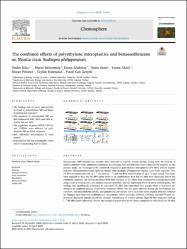| dc.contributor.author | Kilic, Onder | |
| dc.contributor.author | Belivermis, Murat | |
| dc.contributor.author | Sikdokur, Ercan | |
| dc.contributor.author | Sezer, Narin | |
| dc.contributor.author | Aksut, Yunus | |
| dc.contributor.author | Pekmez, Murat | |
| dc.contributor.author | Kosesakal, Taylan | |
| dc.contributor.author | Gercek, Yusuf Can | |
| dc.date.accessioned | 2023-06-02T10:52:30Z | |
| dc.date.available | 2023-06-02T10:52:30Z | |
| dc.date.issued | 2023 | en_US |
| dc.identifier.citation | Kılıç, Ö., Belivermiş, M., Sıkdokur, E., Sezer, N., Aksüt, Y., Pekmez, M., ... & Gerçek, Y. C. (2023). The combined effects of polyethylene microplastics and benzoanthracene on Manila clam Ruditapes philippinarum. Chemosphere, 329, 138664. | en_US |
| dc.identifier.issn | 0045-6535 | |
| dc.identifier.uri | https://doi.org/10.1016/j.chemosphere.2023.138664 | |
| dc.identifier.uri | https://hdl.handle.net/20.500.12294/3877 | |
| dc.description.abstract | Microplastic (MP) toxicity has recently been explored in various marine species. Along with the toxicity of plastics polymer itself, additional substances or pollutants that are absorbed onto it may also be harmful. In the present study, we investigated the combined impacts of polyethylene microplastics (PE MPs) and an organic pollutant (Benzo(a)anthracene, BaA) on Manila clam Ruditapes philippinarum during a one-week exposure. Two PE MPs concentrations (26 mu g L-1 and 260 mu g L-1) and one BaA concentration (3 mu g L-1) were tested. The clams were exposed to BaA and PE MPs either alone or in combination. BaA and PE MPs were incubated before the combined exposure. The biological effects of PE MPs and BaA on the clams were evaluated by considering several assays such as feeding rate, anti-oxidant enzyme activities, and the expression levels of stress-related genes. The feeding rate significantly decreased in individual PE MPs and individual BaA groups while it remained un-changed in combined groups. Superoxide dismutase (SOD) was the most affected among the biochemical pa-rameters. Malondialdehyde (MDA), and glutathione peroxidase (GPx) activities were slightly affected, whereas no changes were observed in glutathione s-transferase (GST) activities. CYP1A1, CYP3A4, and HSP70 gene ex-pressions displayed slightly significant changes. Considering all stressor groups, high PE MPs exposure (260 mu g L-1 PE MPs) more effectively altered the biological parameters in the clams compared to individual low PE MPs and BaA exposure, and their combination. The results also indicated the negligible vector role of PE MPs to transport BaA into the clam tissues. | en_US |
| dc.language.iso | eng | en_US |
| dc.publisher | PERGAMON-ELSEVIER SCIENCE | en_US |
| dc.relation.ispartof | CHEMOSPHERE | en_US |
| dc.identifier.doi | 10.1016/j.chemosphere.2023.138664 | en_US |
| dc.rights | info:eu-repo/semantics/openAccess | en_US |
| dc.subject | Bivalves | en_US |
| dc.subject | Multiple Stressors | en_US |
| dc.subject | Gene Expression | en_US |
| dc.subject | Biomarkers | en_US |
| dc.subject | Bioaccumulation | en_US |
| dc.subject | Vector Role | en_US |
| dc.title | The combined effects of polyethylene microplastics and benzoanthracene on Manila clam Ruditapes philippinarum | en_US |
| dc.type | article | en_US |
| dc.department | Meslek Yüksekokulu, Tıbbi Laboratuvar Teknikleri Programı | en_US |
| dc.authorid | 0000-0002-3659-722X | en_US |
| dc.identifier.volume | 329 | en_US |
| dc.relation.publicationcategory | Makale - Uluslararası Hakemli Dergi - Kurum Öğretim Elemanı | en_US |
| dc.institutionauthor | Sezer, Narin | |
| dc.authorwosid | FWK-4530-2022 | en_US |
| dc.identifier.wosquality | Q1 | en_US |
| dc.identifier.wos | WOS:000987017400001 | en_US |


















